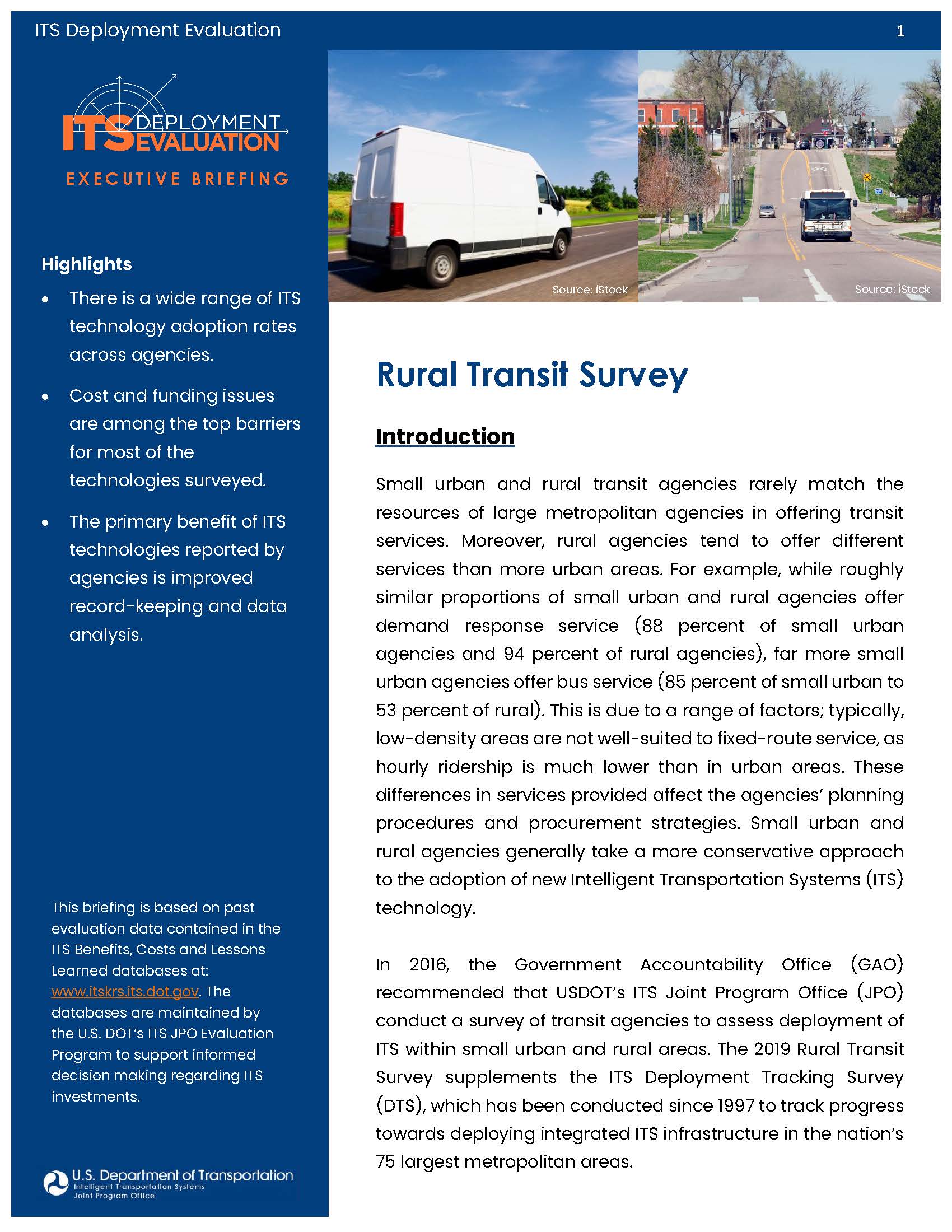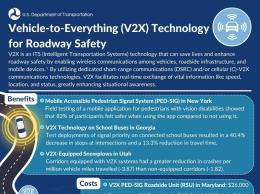Rural Transit Survey
2020 Executive Briefing
BRIEFING HIGHLIGHTS:
- There is a wide range of ITS technology adoption rates across agencies.
- Cost and funding issues are among the top barriers for most of the technologies surveyed.
- The primary benefit of ITS technologies reported by agencies is improved record-keeping and data analysis.
Introduction
Small urban and rural transit agencies rarely match the resources of large metropolitan agencies in offering transit services. Moreover, rural agencies tend to offer different services than more urban areas. For example, while roughly similar proportions of small urban and rural agencies offer demand response service (88 percent of small urban agencies and 94 percent of rural agencies), far more small urban agencies offer bus service (85 percent of small urban to 53 percent of rural). This is due to a range of factors; typically, low-density areas are not well-suited to fixed-route service, as hourly ridership is much lower than in urban areas. These differences in services provided affect the agencies’ planning procedures and procurement strategies. Small urban and rural agencies generally take a more conservative approach to the adoption of new Intelligent Transportation Systems (ITS) technology.
In 2016, the Government Accountability Office (GAO) recommended that USDOT’s ITS Joint Program Office (JPO) conduct a survey of transit agencies to assess deployment of ITS within small urban and rural areas. The 2019 Rural Transit Survey supplements the ITS Deployment Tracking Survey (DTS), which has been conducted since 1997 to track progress towards deploying integrated ITS infrastructure in the nation’s 75 largest metropolitan areas.
| The survey found that usage of ITS technologies may be generally divided into three tiers: High, Medium, and Low usage. |
The ITS JPO conducted the Rural Transit Survey (RTS) in 2019, collecting nearly 250 responses from agencies across the country. It was analyzed to assess the extent to which small urban and rural transit providers were utilizing ITS, as well as to get a better understanding of the benefits and challenges they faced in deployment, including the utilization of existing USDOT resources. The ITS JPO intends to include the surveyed population in future survey efforts.
For survey purposes, “Small urban” agencies were defined as those that received FTA’s Urbanized Area Formula Grants and served 200,000 residents or fewer, while “rural” agencies were those that received FTA’s Rural Area Formula Grants. Only agencies with 10 or more fleet vehicles were considered for the sampling population. More detail on the survey’s methodology, including the determination of the sampling frame and sample size, may be found in the full report.
The survey found that usage of ITS technologies may be generally divided into three tiers: High, Medium, and Low usage. The technologies surveyed ranged in complexity from security cameras to Transit Signal Priority.
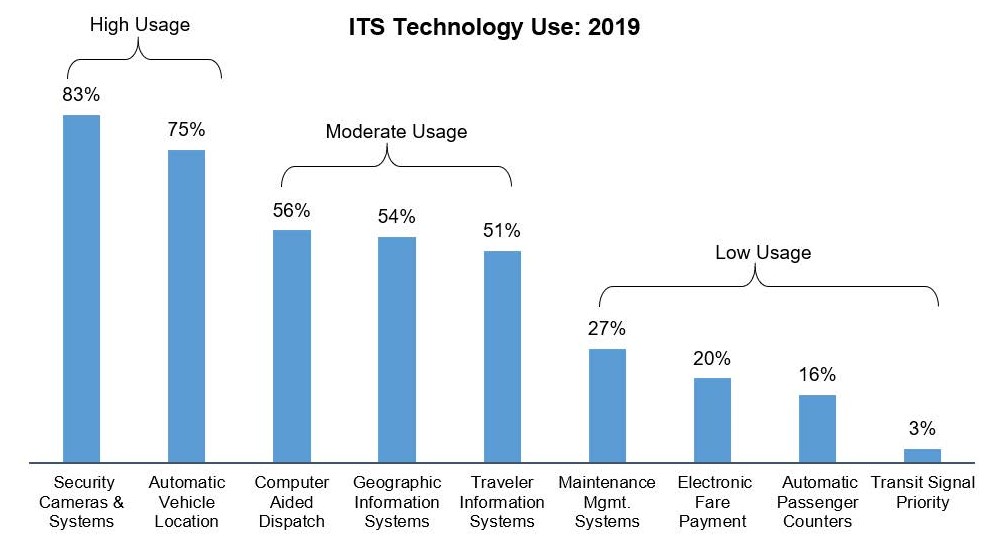
Benefits
Responses to the RTS indicate that most small urban and rural transit providers are not yet recognizing any “great” benefit from ITS technologies. Respondents were shown a list of possible benefits from ITS technology deployments and asked to rate whether their deployments had lead to a “great” realization of each benefit, a “slight” realization, or not to any benefit at all. The “too new to draw conclusions” or “not applicable to deployment” choices received relatively constant rates of response and did not strongly impact the findings.
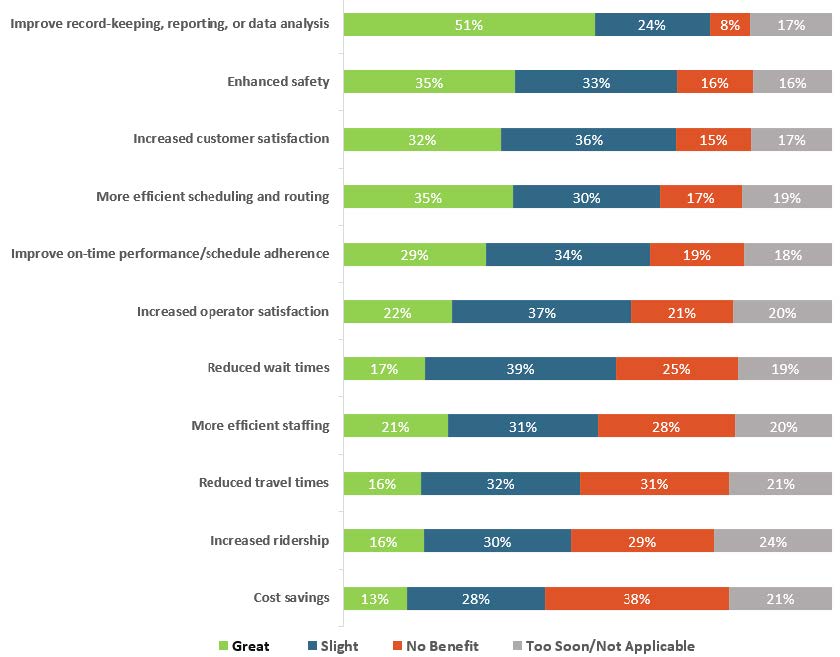
Almost all categories earned at least 50 percent overall positive benefit ratings; the exceptions were reduced travel times, at 48 percent overall positive, and cost savings, at 41 percent overall positive. The most prominent of the benefits was improved record-keeping, reporting, and data analysis, which was recorded as being greatly realized by just over half of responding agencies, and slightly realized by an additional quarter. No other category of benefits received nearly as high a “great benefit” rating.
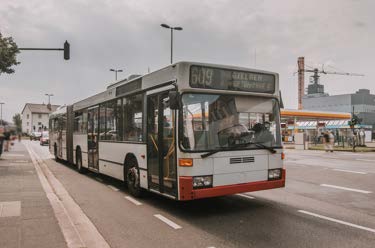
The next closest tier of responses received between 29 and 35 percent “great” ratings: enhanced safety; more efficient scheduling and routing; increased customer satisfaction; and improved ontime performance. Each of these four categories additionally received an overall positive ranking of at least 63 percent—combining “great” and “slight” benefits.
The remaining six categories—increased operator satisfaction, more efficient starting, reduced wait times, increased ridership, reduced travel times, and cost savings, in decreasing order of “great benefit” rating—received less than 25 percent “great” benefit ratings, with between 21 and 38 percent of respondents indicated that they did not experience the benefits at all.
| ITS technologies were found to improve record keeping, reporting and data analysis; enhance safety; improve scheduling and routing; increase customer satisfaction; and improve on-time performance. |
The ranking of overall benefit realization may be attributed to the priorities of rural transit systems. Small urban and rural agencies are less likely to emphasize travel time reduction for example, as they already experience low congestion due to the low population density of their operating areas. Similarly, increased ridership is not as likely to be a priority given that most rural areas focus simply on demand-response trips—administering agencies are more likely to prefer improved service, such as efficient scheduling and routing or improved schedule adherence, instead.
Non-Use of Technology
The 2019 RTS received 246 responses from agencies across the country. These agencies have many different types of goals and opportunities in providing service to their customers. It would be impossible to fit all their experiences neatly into boxes. ITS JPO provided open-ended questions to get feedback from respondents in their own words, which allowed the RTS to color in agencies’ real experiences. For example, as part of the RTS’s technology question batteries, the survey asked agencies for the specific reasons that they were not adopting various services. Ultimately, the report recommended further investigation of its findings to determine how small urban and rural agencies’ needs might differ from more dense areas’ priorities.
| Surveyed Technology | Sample Response |
|---|---|
| Geographic Information System | “We operate in a cluster of small communities. We don’t get lost.” |
| Computer Aided Dispatch | "We do not have WiFi coverage or cell service throughout most of our county.” |
| Electronic Fare Payment | “Our service is free to the public.” |
| Transit Signal Priority | “We only have one stop light in our city—so no need.” |
| Traveler Information Systems | "We have one van and we transport elders. It's not needed for what we do.” |
Best Practices
The results of the RTS found significant challenges facing agencies that might attempt to implement ITS systems. The report was primarily directed at activities that ITS JPO might take to assist small urban and rural agencies in deploying ITS technologies, but there were several points that may be directly addressed to the agencies themselves:
- Make use of USDOT resources: There were significant gaps reported in agencies’ awareness of ITS JPO resources. In particular, only 25 percent of respondents were even aware of the ITS Professional Capacity Building (PCB) Training Program, and only 15 percent of respondents had actually made use of them. Similarly, less than 5 percent of respondents had made use of PCB Technical Support or referenced the ITS JPO Knowledge Resources. These resources are intended for all agencies seeking more information or training and may be valuable to agencies who wish to get a better grasp of the opportunities available to them.
- Leverage data tools: One quarter of agencies indicated that data management was a “great” or “very great” challenge. The ITS JPO Data program has a number of data management tools and templates that small urban and rural transit agencies may find useful.
-
Find ways to combat costs: The cost of implementing ITS systems was a major reported challenge for agencies. The top three highest ranked challenges were all related to the cost of ITS and the limited funding available to agencies. Agencies also reported unexpected costs over the life span of their systems. The ITS JPO’s cost database may be helpful to agencies seeking context for their procurements, while ITS JPO and FTA grants may provide more direct assistance to funding challenges. The RTS report suggested that agencies consider developing proposals on a regional rather than individual agency-by-agency basis, to consolidate costs and support larger projects. The ITS JPO will use the results of the RTS to determine how it may assist in such efforts.Respondents reported that “a lack of funding” and “the cost of the technology” were the two primary reasons for non-use of technologies surveyed.
Small urban and rural communities face different conditions than large metropolitan areas. They are more likely to have limited resources for all their infrastructure investments, not merely for their transit operations. Moreover, new isn’t always better: Agencies should consider their needs and capabilities before procuring potentially costly new services that may be redundant or provide no benefit given their particular situation. Instead, agencies should work to maximize the impact of planned upgrades, using targeted deployments to overcome operational challenges.
References
- Chajka-Cadin, L., M. Petrella, and S. Plotnick, “Intelligent Transportation Systems: Findings from the 2019 Small Urban and Rural Transit Provider Survey.” April 2020. https://rosap.ntl.bts.gov/view/dot/50549
